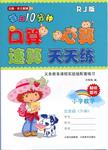题目内容
The 1930s were the year when he wrote one _____ after another, and when his first
collection of _____ was published.
| A.poem, poetry | B.poetry, poem | C.poem, poem | D.poetry, poetry |
A
解析

 每日10分钟口算心算速算天天练系列答案
每日10分钟口算心算速算天天练系列答案When Frida Kahlo's paintings were on show in London, a poet described her paintings as “ a ribbon (丝带)around a bomb”. Such comments seem to suggest Kahlo had a big influence on the art world of her time. Sadly, she is actually a much bigger name today than she was during her time.
Born in 1907 in a village near Mexico City , Kahlo suffered from polio(小儿麻痹症)at the age of seven. Her spine (脊柱)became bent as she grew older. Then, in 1925, her back was broken in several places in a school-bus accident. Throughout the rest of her life, the artist had many operations, but noting was able to cure the terrible pain in her back. However, the accident had an unexpected side effect. While lying in her bed recovering, Kahlo taught herself to paint.
In 1929, she got married to Diego Rivera, another famous Mexican artist. Rivera’s strong influences on Kahlo’s style can be seen in her early works, but her later works from the 1940s, known today as her best works, show less influence from her husband.
Unfortunately, her works did not attract much attention in the 1930s and1940s, even in her home country. Her first one-woman show in Mexico was not held until 1953. For more than a decade after her death in 1954, Kahlo’s works remained largely unnoticed by the world, but in the 1970s her works began to gain international fame at last.
【小题1】What does the phrase “a much bigger name” in paragraph 1 most nearly mean?
| A.a far better artist | B.a much more famous person |
| C.a much stronger person | D.a far more gifted artist |
| A.back injuries | B.her bent spine | C.polio | D.the operations she had |
| A.1930s | B.1970s | C.1950s | D.1940s |
| A.Devotion | B.Encouragement | C.Worry | D.Sympathy(同情) |
Book now to see Keira Knightley and Elisabeth Moss star in The Children’s Hour at the Comedy Theatre in London.
Dates: 22 January 2011 to 31 January 2011
Times: 22 Jan 2011 6:30 PM; 24—29 Jan 2011 7:30 PM; 29 Jan 2011 2:30 PM; 31 Jan 2011 7:30 PM.
Place: Comedy Theatre
The Children’s Hour
The Children’s Hour by Lillian Hellman is a striking play about the power of a lie. Karen Wright (Keira Knightley) and Martha Dobie (Elisabeth Moss) run a girls’ boarding school in the 1930s New England. When an angry student starts a rumour that the two headmistresses are having a lesbian (女同性恋者) affair, it gradually destroys the women’s careers, relationships and lives. The Children’s Hour is an upsetting story of cheat, shame and courage.
Banned in London and several cities across America, The Children’s Hour received its world opening on Broadway in 1934. Generations on, its exploration of a culture of fear remains remarkably relevant.
Keira Knightley and Elisabeth Moss Star
Keira Knightley, nominee (被提名者) for Best Actress 2010 Evening Standard Awards for The Misanthrope, returns to the London stage. Knightley starred in Love Actually, The Pirates of the Caribbean Trilogy, Pride and Prejudice.
Elisabeth Moss, best-known for playing Peggy Olson in Mad Men, made her Broadway stage debut (首映) in David Mamet’s Speed the Plow in 2008. The Children’s Hour will be her West End debut.
Book The Children’s Hour Tickets
Book theatre tickets to see The Children’s Hour at London’s Comedy Theatre today. With two big stars in the leading roles, The Children’s Hour tickets are sure to sell fast. Book yours online now with Visit London’s secure ticket booking partner on this wetsite. Just click the green book button to buy your The Children’s Hour tickets.
【小题1】If you visit London in January, at which time can you see the play?
| A.21 Jan 2011 6:30 PM. | B.23 Jan 2011 2:30 PM. |
| C.26 Jan 2011 2:30 PM. | D.31 Jan 2011 7:30 PM. |
| A.used to be forbidden | B.is about the power of love |
| C.was set in England in the 1930s | D.is not popular these days |
| A.Keira Knightley was awarded Best Actress 2010 Evening Standard Awards. |
| B.Elisabeth Moss ever performed on the Broadway stage. |
| C.Without the two big stars, people would not buy the play’s tickets. |
| D.You can only buy a ticket with Visit London’s secure ticket booking partner. |
| A.In a movie magazine. | B.In the newspaper. |
| C.On the website. | D.In an academic journal. |